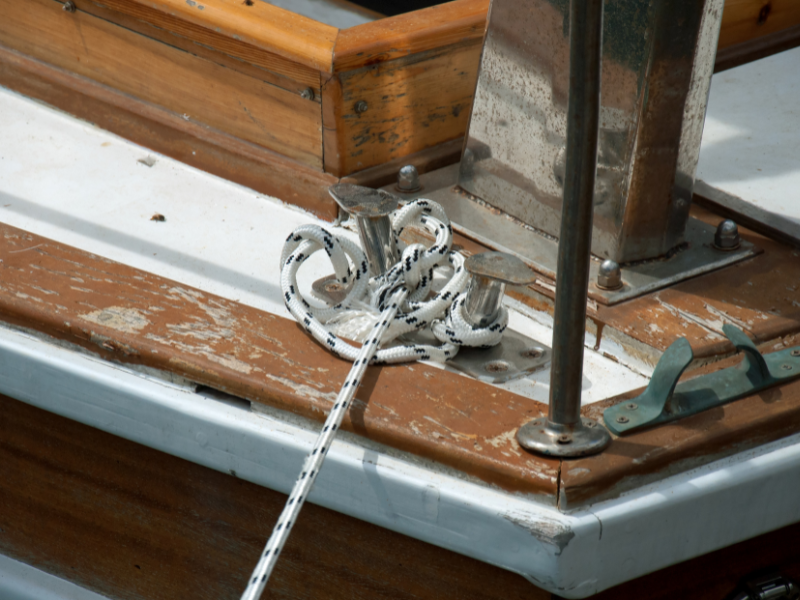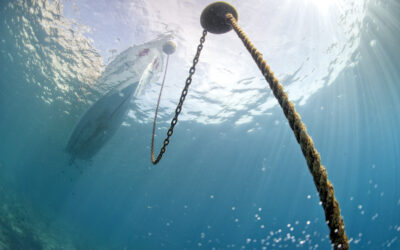Handling lines is a common part of many things every boat owner must do—dock a boat, tying up a boat, and anchoring a boat, are just a few examples. And when you are handling lines, there’s a good chance there may be some knot tying too. Here are five commonly used boating knots that every boater should learn— Bowline knot, Cleat Hitch, Clove Hitch, Half-Hitch (also called the Overhand Knot) and the Figure Eight—with simple steps showing you how to make them and what each knot is used for. If you are more of a visual person, with just a quick search, you can find plenty of YouTube videos available to watch.
Bowline Knot The bowline is used to create a loop in the end of a line, which can come in handy for reasons ranging from securing a line to a piling or attaching two lines together. The big advantage it has over other knots one might use to put a loop in the end of a line is that it’s very easy to un-do, even after the line’s been under a large amount of tension.
- Step 1: Make a small loop in the line a couple feet from the end, then pass the end of the line up through the loop you just made.
- Step 2: Wrap the end around the main line above the loop, turn the end back down, and thread it back down through the loop.
- Step 3: Tug hard on the end and on the main line above the loop you’ve created, to snug the knot down.
Cleat Hitch Knot This simple knot can be used whether you’re pulling into the fuel dock or cleating off an anchor line, you need to know the cleat hitch.
- Step 1: Wrap the line around one side of the base of a cleat, under the “horns” (the ends on either side).
- Step 2: Pull the line across the top of the cleat, then loop it under the horn on the other side.
- Step 3: Reverse directions, and go across the top of the cleat going the other way.
- Step 4: To finish the cleat hitch, reverse direction again as though you were going to wrap under the opposite horn again. But instead of passing the line under it, form a small loop and flip it upside-down. Put the loop you just made over the horn, the pull hard so the line cinches down on itself. Then repeat the same process, on the second horn of the cleat.
Clove Hitch Knot Often referred to as the fender knot—one of the most important to learn. The Clove Hitch knot comes in handy when you want to secure a line to a rail. Many boaters use them for tasks like hanging coils of line for neat stowage, or securing fenders so they hang down from a bow rail. You can actually tie the clove hitch in one of two different ways.
If you’re tying it around a rail:
- Step 1: Wrap the line one time around the rail.
- Step 2: Begin wrapping around the rail a second time, with the line crossing over top of the first wrap. Finish the second wrap, but before pulling it tight, pass the tag end back underneath. Then tug, to secure the clove hitch in place.
If you’re tying a clove hitch to a pole with an accessible end:
- Step 1: Make a loop, and pass it over the end of the pole.
- Step 2: Make a second loop and flip it over so the tag end faces the first loop, then pull it tight.
A word of caution about the Clove Hitch Knot: if the line isn’t under slight pressure all the time, or if it rotates on the rail or pole, it can come undone. So never use this knot for heavy-duty tasks like securing a boat to a dock. Some people even like to add a half hitch knot on top of a clove hitch, just to be safe.
Half Hitch (Overhand) Knot This is just about the simplest knot there is, but beware that half-hitches aren’t reliable on their own. They’re a good way to secure the end of the line after tying a different knot, and two half hitches together work well for securing a light-duty load. You can tie a half hitch both in a line and around a rail.
- Step 1: Pass the tag end of the line across the main line, pull it through the loop you just made, and give it a tug.
Figure Eight Knot The figure eight knot is useful when you want to stop a line from passing through something, like a chock or a pulley (and is sometimes called a “stopper” knot for that reason). Be careful, though, because if both ends of the line are put under a lot of stress, you may have difficulty getting the figure eight back out of the line later on.
- Step 1: Make a loop in the line.
- Step 2: Wrap the tag end over the main line, and pass it back through the loop.
- Step 3: Pull both ends to cinch it tight, or push the knot to adjust its position and then cinch it tight.
Now that you have mastered common boating knots, how about finding the perfect dock solution. That is where we can help. Contact us to discuss you options.



